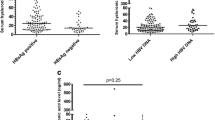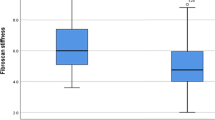Abstract
Background and aims
HBsAg seroclearance is the most desired endpoint in chronic hepatitis B (CHB) but occurs uncommonly. Recent studies have shown baseline HBsAg levels to be predictive of HBsAg loss up to 10 years. We report the 28-year rates of HBsAg loss and outcomes in the Kawerau study cohort from New Zealand, and assess the predictive value of baseline HBsAg levels to predict long-term HBsAg loss.
Methods
The 1984 Kawerau community study identified 572 CHB patients, followed up for 28 years (41 % HBeAg-positive, median age 17 years, range 1–71 years). In 2012, surviving individuals attended a local clinic for an interview, blood tests and transient elastography.
Results
384/218 (74 %) surviving individuals attended the clinic in 2012. Spontaneous HBsAg loss occurred in 145 (33 %) after 12,702 person-years of follow-up (1.14 per 100 person-years). Liver stiffness measurements were significantly lower if HBsAg loss occurred <50 years (mean 6.1 kPa) versus >50 years (mean 11.6 kPa), p = 0.0002. No HCC occurred following HBsAg loss (median follow-up 72 months). Predictors of HBsAg loss were older age and lower baseline HBsAg level (HR for HBsAg loss at 28 years 2.7 (95 % CI 1.7–4.2), 6.7 (95 % CI 3.9–11.4) and 9.4 (95 % CI 5.2–16.9), respectively, for HBsAg 1000–9999, 100–999 and <100 IU/mL compared to HBsAg >10,000 IU/mL at baseline, (p < 0.0001). Baseline HBsAg was a superior predictor of HBsAg loss compared to HBV DNA at all time-points: AUROC at 15 years: 0.87 (95 % CI 0.82–0.93) versus 0.73 (95 % CI 0.66–0.80) (p < 0.0001) and AUROC at 28 years: 0.74 (95 % CI 0.69–0.79) versus 0.67 (95 % CI 0.62–0.72) (p = 0.0007). The optimal cut-off HBsAg level to predict HBsAg seroclearance at 28 years is HBsAg <10,000 IU/mL (sensitivity 72 %, specificity 64 %, NPV 88 %).
Conclusions
Rates of HBsAg loss in our community cohort were high, and occurred earlier than previously reported. Earlier HBsAg loss was associated with less severe liver fibrosis. Baseline HBsAg level was a good predictor of long-term HBsAg loss up to 28 years and superior to HBV DNA.




Similar content being viewed by others
References
Fattovich G, Giustina G, Realdi G, Corrocher R, Schalm SW. long-term outcome of hepatitis B e antigen-positive patients with compensated cirrhosis treated with interferon alfa. European Concerted Action on Viral Hepatitis (EUROHEP). Hepatology. 1997;26:1338–1342
Ahn SH, Park YN, Park JY, Chang HY, Lee JM, Shin JE, et al. long-term clinical and histological outcomes in patients with spontaneous hepatitis B surface antigen seroclearance. J Hepatol 2005;42:188–194
Niederau C, Heintges T, Lange S, Goldmann G, Niederau CM, Mohr L, et al. Long-term follow-up of HbeAg-positive patients treated with interferon alfa for chronic hepatitis B. N Engl J Med. 1996;334(22):1422–1427
Yu MW, Hsu FC, Sheen IS, Chu CM, Lin DY, Chen CJ, et al. Prospective study of hepatocellular carcinoma and liver cirrhosis in asymptomatic chronic hepatitis B virus carriers. Am J Epidemiol. 1997;145(11):1039–1047
Liaw YF, Sung JJ, Chow WC, Farrell G, Lee CZ, Yuen H, et al. Lamivudine for patients with chronic hepatitis B and advanced liver disease. N Engl J Med. 2004;351(15):1521–1531
Lin SM, Sheen IS, Chien RN, Chu CM, Liaw YF. Long-term beneficial effect of interferon therapy in patients with chronic hepatitis B virus infection. Hepatology. 1999;29(3):971–975
Yuen MF, Hui CK, Cheng CC, et al. long-term follow-up of interferon alfa treatment in Chinese patients with chronic hepatitis B infection: the effect of hepatitis B e antigen seroconversion and the development of cirrhosis-related complications. Hepatology. 2001;34:139–145
Chu CM, Liaw YF. HBsAg seroclearance in asymptomatic carriers of high endemic areas: appreciably high rates during a long-term follow-up. Hepatology. 2007;45:1187–1192
Liaw YF, Sheen IS, Chen TJ, Chu CM, Pao CC. Incidence, determinants and significance of delayed clearance of serum HBsAg in chronic hepatitis B virus infection: a prospective study. Hepatology. 1991;13(4):627–631
McMahon BJ, Holck P, Bulkow L, Snowball M. Serological and clinical outcomes of 1536 Alaska natives chronically infected with hepatitis B virus. Ann Intern Med. 2001;135(9):759–768
Kim JH, Lee JH, Park SJ, et al. Factors associated with natural seroclearance of hepatitis B surface antigen and prognosis after seroclearance: a prospective follow-up study. Hepatogastroenterology. 2008;55:576–581
Simonetti J, Bulkow L, McMahon BJ, Homan C, Snowball M, Negus S, et al. Clearance of hepatitis B surface antigen and risk of hepatocellular carcinoma in a cohort chronically infected with hepatitis B virus. Hepatology. 2010;51(5):1531–1537
De Franchis R, Meucci G, Vecchi M, Tatarella M, Colombo M, Del Ninno E, et al. The natural history of asymptomatic hepatitis B surface antigen carriers. Ann Intern Med. 1993;118(3):191–194
Yuen MF, Wong DK, Sablon E, Tse E, Ng IO, Yuan HJ, et al. HBsAg seroclearance in chronic hepatitis B in the Chinese: virological, histology and clinical aspects. Hepatology. 2004;39:1694–1701
Arase Y, Ikeda K, Suzuki F, Suzuki Y, Saitoh S, Kobayashi M, et al. Long-term outcome after hepatitis B surface antigen seroclearance in patients with chronic hepatitis B. Am J Med. 2006;19:e9–e15
Flink HJ, van Zonneveld M, Hansen BE, et al. Treatment with peg-interferon alpha-2b for HbeAg-positive chronic hepatitis B: HbsAg loss is associated with HBV genotype. Am J Gastroenterol. 2006;101:297–303
Liu J, Yang HI, Lee MH, Lu SN, Jen CL, Wang LY, et al. Incidence and determinants of spontaneous hepatitis B surface antigen seroclearance: a community-based follow-up study. Gastroenterology. 2010;139:474–482
Lim TH, Gane E, Moyes C, Borman B, Cunningham C. Serological and clinical outcomes of horizontally transmitted chronic hepatitis B infection in New Zealand Māori: results from a 28-year follow-up study. Gut. 2015;64(6):966–72
Milne A, Allwood GK, Moyes CD, et al. A seroepidemiological study of the prevalence of hepatitis B infections in a hyperendemic New Zealand Community. Int J Epidmiol. 1987;16:84–90
Diminsky D, Moav N, Gorecki M, Barenholz Y. Physical, chemical and immunological stability of CHO–derived hepatitis B surface antigen (HBsAg) particles. Vaccine. 1999;18(1–2):3–17
Chen CJ, Yang HI, Su J, Jen CL, You SL, Lu SN, et al. Risk of hepatocellular carcinoma across a biological gradient of serum hepatitis B virus DNA level. JAMA. 2006;295:65–73
Iloeje UH, Yang HI, Su J, Jen CL, You SL, Chen CJ. Predicting cirrhosis risk based on the level of circulating hepatitis B viral load. Gastroenterology. 2006;130:678–686
Iloeje UH, Yang HI, Jen CL, Su J, Wang LY, You SL. Risk and predictors of mortality associated with chronic hepatitis B infection. Clin Gastroenterol Hepatol. 2007;5:921–931
Seto WK, Wong DK, Fung J, Hung IF, Fong DY, Yuen JC, et al. A large case-control study on the predictability of hepatitis B surface antigen (HBsAg) levels 3 years before HBsAg seroclearance. Hepatology. 2012;56:812–819
Kim GA, Lee HC, Kim MJ, Ha Y, Park EJ, An J, et al. Incidence of hepatocellular carcinoma after HBsAg seroclearance in chronic hepatitis B patients: a need for surveillance. J Hepatol. 2015. doi:10.1016/j.jhep.2014.11.031
Chan HLY, Wong GLH, Tse CH, Chan HY, Wong VWS. Viral determinants of hepatitis B surface antigen seroclearance in hepatitis B e antigen-negative chronic hepatitis B patients. J Infect Dis. 2011;204:408–413
Liu J, Lee MH, Batrla-Utermann R, Jen CL, Iloeje UH, Lu SN, et al. A predictive scoring system for the seroclearance of HBsAg in HBeAg-seronegative chronic hepatitis B patients with genotype B or C infection. J Hepatol. 2013;58:853–860
Chang MH, Chiu YC, Wu JF, Lin CY, Ni YH, Chen HL et al. Spontaneous clearance of hepatitis B surface antigen during the natural history of chronic hepatitis B virus infection. Hepatology 2011;54:Abstr 731
Chen YC, Jeng WJ, Chu CM, Liaw YF. Decreasing levels of HBsAg predict HBsAg seroclearance in patients with inactive chronic hepatitis B virus infection. Clin Gastroenterol Hepatol. 2012;10:297–302
Tseng TC, Liu CJ, Su TH, Wang CC, Chen CL, Chen PJ, et al. Serum hepatitis B surface antigen levels predict surface antigen loss in hepatitis B e antigen seroconverters. Gastroenterology. 2011;141(2):517–525
Tseng TC, Liu CJ, Yang HC, Su TH, Wang CC, Chen CL, et al. Determinants of spontaneous surface antigen loss in hepatitis B e antigen-negative patients with low viral load. Hepatology. 2012;55:68–76
Chen YC, Sheen IS, Chu CM, Liaw YF. Prognosis following spontaneous HBsAg seroclearance in chronic hepatitis B patients with or without concurrent infection. Gastroenterology. 2002;123:1084–1089
Huo TI, Wu JC, Lee PC, et al. Sero-clearance of hepatitis B surface antigen in chronic carriers does not necessarily imply a good prognosis. Hepatology. 1998;28(1):231–236
Yuen MF, Wong DKH, Fung J, Ip P, But D, Hung I, et al. HBsAg seroclearance in chronic hepatitis B in Asian patients: replicative level and risk of hepatocellular carcinoma. Gastroenterology. 2008;135(4):1192–1199
Fattovich G, Giustina G, Sanchez-Tapias J, Quero C, Mas A, Olivotto PG, et al. Delayed clearance of serum HBsAg in compensated cirrhosis B: relation to interferon alpha therapy and disease prognosis. Am J Gastroenterol. 1998;93:896–900
Dragosics B, Ferenci P, Hitchman E, et al. long-term follow-up study of asymptomatic HBsAg-positive voluntary blood donors in Austria: a clinical and histologic evaluation of 242 cases. Hepatology. 1987;7:302–306
Sarasin FP, Giostra E, Hadengue A. Cost-effectiveness of screening for detection of small hepatocellular carcinoma in western patients with Child-Pugh class A cirrhosis. Am J Med. 1996;101:422–434
Arguedas MR, Chen VK, Eloubeidi MA, Fallon MB. Screening for hepatocellular carcinoma in patients with hepatitis C cirrhosis: a cost-utility analysis. Am J Gastroenterol. 2003;98:679–690
Lin OS, Keeffe EB, Sanders GD, Owens DK. Cost-effectiveness of screening for hepatocellular carcinoma in patients with cirrhosis due to chronic hepatitis C. Aliment Pharmacol Ther. 2004;19:1159–1172
Thompson Coon J, Rogers G, Hewson P, Wright D, Anderson R, Jackson S, et al. Surveillance of cirrhosis for hepatocellular carcinoma: a cost-utility analysis. Br J Cancer. 2008;98:1166–1175
Bruix J, Sherman M. Management of hepatocellular carcinoma: an update. Hepatology 2011;53(3):1020–1022
Acknowledgements
Helen Purcell of The Hepatitis Foundation of New Zealand.
Author information
Authors and Affiliations
Corresponding author
Ethics declarations
Conflict of interest
Tien Huey Lim, Edward Gane, Chris Moyes, Barry Borman and Chris Cunningham declare that they have no conflict of interest.
Ethical approval
The 1984 study was approved by the local ethics committee and funded by the New Zealand Medical Research Council. The current 2012 follow-up study was approved by the Northern Y ethics committee and funded by the Health Research Council of New Zealand.
Informed consent
All procedures followed were in accordance with the ethical standards of the Northern Y ethics committee and with the Helsinki Declaration of 1975, as revised in 2008 (5). Informed consent was obtained from all patients for being included in the study.
Financial support
This study is funded by the Health Research Council of New Zealand and the New Zealand Society of Gastroenterology who do not have any role in the study design, collection, analysis or interpretation of data.
Rights and permissions
About this article
Cite this article
Lim, T.H., Gane, E., Moyes, C. et al. HBsAg loss in a New Zealand community study with 28-year follow-up: rates, predictors and long-term outcomes. Hepatol Int 10, 829–837 (2016). https://doi.org/10.1007/s12072-016-9709-6
Received:
Accepted:
Published:
Issue Date:
DOI: https://doi.org/10.1007/s12072-016-9709-6




